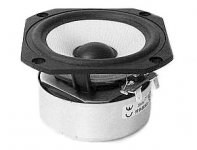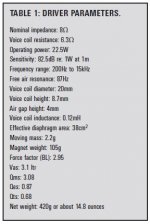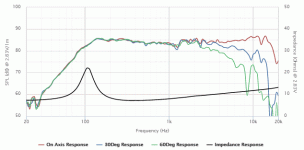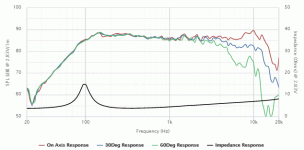That made me laugh wesayso!
Thank you again for your insight and links. I will have a good read of that thread.
Bizarrely to me the 4ohm version has a slightly better response graph and I thought is the model used in the ids25 but I could be wrong.
I have a feeling I will be heading back to the tc9 though.
If only the sb65 was a little cheaper, I would do 30 a side of those...
I am leaning towards an oval cross section enclosure with a chamber for each driver and bending ply to skin the outside at present.
I have looked at schedule 40 pipe and aluminium box section, but both don't quite work with the tc9 frame.
To my knowledge, the driver used in the IDS was the shielded Vifa 9BGS 119/8 which is no longer available except on special order.
It's definitely an 8 ohm driver in the IDS as confirmed by Roger Russell:
[excerpt from his article]
The Vifa 9BG 119/8 is probably the closest related driver available today. Also known as the Peerless TG9FD-10-08
The TC9 FD18-08 is also known as Viva 9BN 119/8 and Peerless FR35/8. Google searches on the related names give even more useful data
Even that is the same on the BGS 119/8.
I have come across at least 3 Rev. sheets of the TC9. Tiny differences in each one. I'm pretty sure I posted all of them before somewhere. But if you want I can look em up again. I'll include the most recent one (2014) to this post.
Attachments
Last edited:
I can't offer any real world experience with the TG9 drivers. The reasons I did not pursue them were cost and greater difficulty in getting hold of the 8 ohm TG9.
In a single speaker the cost is almost irrelevant but when you need 50 or more then it adds up. The TG9 is almost double the price.
I didn't want a 4 ohm speaker and wiring a 4 ohm driver back to 8 in an array is awkward with an uneven amount of drivers.
As to the cabinet I think getting a smooth termination from frame or surround is important to reduce diffraction. The only way I could think to do that was either sink the driver in (or add a thin board on top to match the edge) or a slight waveguide like wesayso. That could be harder in an oval design.
I really wanted to make a curved cabinet with a frame underneath and then layers of thin ply to form the sides but I decided it wasn't worth the effort or difficulty due to the size. If I had I still wouldn't be finished.
I can only say that making anything this tall is more of a challenge than I thought at the start.
In a single speaker the cost is almost irrelevant but when you need 50 or more then it adds up. The TG9 is almost double the price.
I didn't want a 4 ohm speaker and wiring a 4 ohm driver back to 8 in an array is awkward with an uneven amount of drivers.
As to the cabinet I think getting a smooth termination from frame or surround is important to reduce diffraction. The only way I could think to do that was either sink the driver in (or add a thin board on top to match the edge) or a slight waveguide like wesayso. That could be harder in an oval design.
I really wanted to make a curved cabinet with a frame underneath and then layers of thin ply to form the sides but I decided it wasn't worth the effort or difficulty due to the size. If I had I still wouldn't be finished.
I can only say that making anything this tall is more of a challenge than I thought at the start.
My strange and crazy way of building the arrays was a once in a lifetime opportunity for me where I had more time than money. I had already bought most of what I needed and the original plan included CNC or water yet cutting.
I was pretty convinced these arrays were going to be the last speaker I needed so I went all out. Arrays are strange speakers in the way they act within a room. I couldn't think of another concept that makes it this easy to lessen the effect of early reflections, including the floor and ceiling.
Well aside from my dream of one day playing with full range Synergy horns within a bass array.
But that's still sort of an array, isn't it?
I was pretty convinced these arrays were going to be the last speaker I needed so I went all out. Arrays are strange speakers in the way they act within a room. I couldn't think of another concept that makes it this easy to lessen the effect of early reflections, including the floor and ceiling.
Well aside from my dream of one day playing with full range Synergy horns within a bass array.
But that's still sort of an array, isn't it?
Vertical laminated ply cabinet construction
Hiya Fluid,
I found making the cabinets out of laminated plywood the best method. Either a vertical stack or layers similar to the attached sketch or a front to back stack like SM 15 cabinets on my website.
The beauty of vertical stacking for tall line arrays is that you can easily design the precise internal volume and have almost any external shape with internal waves or ridges to reduce internal reflections.
Also, its actually cost effective to get two or three sheets of 24mm ply CNC'd when you are producing 150 to 200 or so identical layers.
Once you have all the layers accurately machined gluing them all up is not that difficult it just takes a bit of time and effort... The joy of DIY.... Or pay a joiner to that part to and concentrate on the driver installation & electronics.
All the very best
Derek.
CIA – New SM 15 monitors | Custom Install Audio
As to the cabinet I think getting a smooth termination from frame or surround is important to reduce diffraction. The only way I could think to do that was either sink the driver in (or add a thin board on top to match the edge) or a slight waveguide like wesayso. That could be harder in an oval design.
I really wanted to make a curved cabinet with a frame underneath and then layers of thin ply to form the sides but I decided it wasn't worth the effort or difficulty due to the size. If I had I still wouldn't be finished.
I can only say that making anything this tall is more of a challenge than I thought at the start.
Hiya Fluid,
I found making the cabinets out of laminated plywood the best method. Either a vertical stack or layers similar to the attached sketch or a front to back stack like SM 15 cabinets on my website.
The beauty of vertical stacking for tall line arrays is that you can easily design the precise internal volume and have almost any external shape with internal waves or ridges to reduce internal reflections.
Also, its actually cost effective to get two or three sheets of 24mm ply CNC'd when you are producing 150 to 200 or so identical layers.
Once you have all the layers accurately machined gluing them all up is not that difficult it just takes a bit of time and effort... The joy of DIY.... Or pay a joiner to that part to and concentrate on the driver installation & electronics.
All the very best
Derek.
CIA – New SM 15 monitors | Custom Install Audio
Attachments
I like the idea stacked plywood like wesayso did but as he found out it is not without it's issues when over 2m tall.
In Australia good quality plywood is incredibly expensive and I don't think the cost would have been justified in a substantially better outcome.
With my CNC design plywood would have been more problematic due to expansion and shrinkage after the machining as I wasn't able to assemble it straight away.
I would like to have used plywood but it wasn't a good option for me and I am happy with the cabinet construction method I chose. If you don't have the same constraints as I did then all sorts of constructions methods become available.
In Australia good quality plywood is incredibly expensive and I don't think the cost would have been justified in a substantially better outcome.
With my CNC design plywood would have been more problematic due to expansion and shrinkage after the machining as I wasn't able to assemble it straight away.
I would like to have used plywood but it wasn't a good option for me and I am happy with the cabinet construction method I chose. If you don't have the same constraints as I did then all sorts of constructions methods become available.
I can't offer any real world experience with the TG9 drivers. The reasons I did not pursue them were cost and greater difficulty in getting hold of the 8 ohm TG9.
In a single speaker the cost is almost irrelevant but when you need 50 or more then it adds up. The TG9 is almost double the price.
I didn't want a 4 ohm speaker and wiring a 4 ohm driver back to 8 in an array is awkward with an uneven amount of drivers.
As to the cabinet I think getting a smooth termination from frame or surround is important to reduce diffraction. The only way I could think to do that was either sink the driver in (or add a thin board on top to match the edge) or a slight waveguide like wesayso. That could be harder in an oval design.
I really wanted to make a curved cabinet with a frame underneath and then layers of thin ply to form the sides but I decided it wasn't worth the effort or difficulty due to the size. If I had I still wouldn't be finished.
I can only say that making anything this tall is more of a challenge than I thought at the start.
Just get a pair of TG9 for fun, didn't know what I was missing with the otherwise fine TC9 until I got a pair for fun.

upload gifs online
Last edited:
Thanks for all the input guys.
Here are copies of the graphs for the 8ohm and 4 ohm tg9 drivers, the first is the 8 ohm.
I think the 4 ohm looks nicer, but perhaps I am missing something...
Regarding translam and CNC approach. I may need to get some quotes....it would certainly make my life easier!
Here are copies of the graphs for the 8ohm and 4 ohm tg9 drivers, the first is the 8 ohm.
I think the 4 ohm looks nicer, but perhaps I am missing something...
Regarding translam and CNC approach. I may need to get some quotes....it would certainly make my life easier!
Attachments
Acknowledging the bass difference, should the TC7 be a part of the conversation? A little bit better up top, albeit perhaps too much of a compromise down low. And we'd have to discuss it more on an equal-cost basis, as you *should* be able to buy back some of the missing SD with the cheaper TC7.
I'm loathe to know how best to build one of these guys dimensionally stable though. My first instinct would be HDPE machined. Aluminum obviously could work, too. Honeycomb(foam)/fiberglass for the sides and back.
I'm loathe to know how best to build one of these guys dimensionally stable though. My first instinct would be HDPE machined. Aluminum obviously could work, too. Honeycomb(foam)/fiberglass for the sides and back.
I don't think I will be going from line arrays to single drivers in either versionJust get a pair of TG9 for fun, didn't know what I was missing with the otherwise fine TC9 until I got a pair for fun.
I think the 4 ohm looks nicer, but perhaps I am missing something...
Regarding translam and CNC approach. I may need to get some quotes....it would certainly make my life easier!
Of those two graphs the 4ohm looks better, I actually think that the TC9 holds it's own by the look of the graphs. If you can get the TG9 at the same price or close to and you like the look of the cone go for it. I can't see much of a difference to warrant picking one over the other besides price and looks.
The cost of the CNC can vary wildly between suppliers so try a few. It is the time it takes the machine that costs the money, so simple is cheaper. My front panel for the inset frames and pilot holes for all the drivers was the bulk of the cost, the grooves in the panels to slot it together was the other factor. Even in MDF the cabinet cost with CNC was not that far off the cost of the drivers.
My preferred idea was to make it like an aeroplane wing. Get the superstructure cut from CNC and then use thin ply in layers to form the outer skin.
Acknowledging the bass difference, should the TC7 be a part of the conversation? A little bit better up top, albeit perhaps too much of a compromise down low. And we'd have to discuss it more on an equal-cost basis, as you *should* be able to buy back some of the missing SD with the cheaper TC7.
I'm loathe to know how best to build one of these guys dimensionally stable though. My first instinct would be HDPE machined. Aluminum obviously could work, too. Honeycomb(foam)/fiberglass for the sides and back.
We must be looking at different datasheets as the two TC7 drivers I have seen do not look better. Any 2.5" driver means the need to cross to subs regardless, there isn't enough height in any living room to get the Sd back.
The cabinet needs to have some weight (mass) to it and not just stiffness. Plywood or MDF are perfectly good materials to use. The difficulty with plywood used in long sections is it's tendency to twist if you don't weight it down or fix it soon after being cut. Vertical translam solves that problem but introduces another of maintaining alignment without cracking down the road.
I think wesayso's epoxy matt and the leather look fabric that I glued all around mine are a very good way to keep the cabinet together and stopping it from moving too much over time. It's like a long term clamp.
You mean the pressed steel TC7 drivers that are more expensive than the (original) TC9? In my humble opinion they are not in the same league.
The original TC9 was developed by Scan Speak and punches above it's weight. They have a whole new series at Tymphany now, all made different compared to the classics and I only see them as a cost saving future replacement. There is a reason the TC9 is still in production. Originally meant as TV speakers but nowadays to big to fit that purpose but it has become a classic, just like the Vifa ring radiators. From a time all experiments from Scan Speak were tested first under the Vifa name brand.
The TG9 was also targeted at the TV marked, for the more expensive TV models.
When Scan Speak and Peerless/Vifa split the 10F was born.
One day we are going to loose these marvels to cheaper to make models which sell at higher prices. Get em while you can!
The original TC9 was developed by Scan Speak and punches above it's weight. They have a whole new series at Tymphany now, all made different compared to the classics and I only see them as a cost saving future replacement. There is a reason the TC9 is still in production. Originally meant as TV speakers but nowadays to big to fit that purpose but it has become a classic, just like the Vifa ring radiators. From a time all experiments from Scan Speak were tested first under the Vifa name brand.
The TG9 was also targeted at the TV marked, for the more expensive TV models.
When Scan Speak and Peerless/Vifa split the 10F was born.
One day we are going to loose these marvels to cheaper to make models which sell at higher prices. Get em while you can!
I was using TMM's shootout information on small full-ranges -- the tc7 looks just a little smoother response above 5'ish kHz. As I said, probably not worth the loss in SD, if the benefit is even real. Parts-express's measurements suggest the opposite, however, so I might well be in the weeds.
And my $/speaker was through parts-express, so regionally things may look very different. In either case, the TC9 definitely wins in the $/sd comparison between the two.
And my $/speaker was through parts-express, so regionally things may look very different. In either case, the TC9 definitely wins in the $/sd comparison between the two.
- Status
- This old topic is closed. If you want to reopen this topic, contact a moderator using the "Report Post" button.
- Home
- Loudspeakers
- Full Range
- BMR floor to ceiling straight full range driver array.



